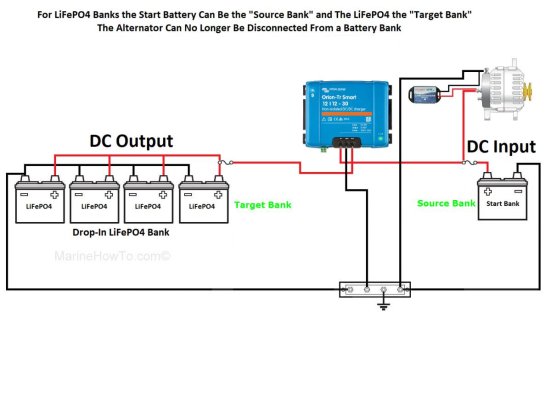The linked article is long and rambling with many nuggets of good information, though requires a bit of dedication to mine.
Deep into the article is the following:
CAN I USE MY STOCK ALTERNATOR?
The short answer is we do not advise this for charging lithium iron phosphate batteries directly.You can however use your stock alternator if i it is behind a DC to DC charger that serves to protect it and that provides the proper charge profile for the lithium iron phosphate batteries.
WHY?
1-A stock alternator rarely has the correct charging voltages for lithium iron phosphate batteries.
2-They can over absorb the batteries resulting in over-charge damage
3-The absorption voltage is very often too high (see below)which can lead to BMS load-dumps
4-Stock alternators do not FLOAT, they only do bulk and absorption.
5-Alternator heat damage
One gripe I have about Rod Collins when it comes to LFP is he talks a lot about Absorb/Bulk charging parameters for programming external regulators, but won't give specific information on what these should be, or a process to determine what they should be based on battery OEM specs. He seems to shy away from specifics for LFP - lots of information on what not to do, lean on what to do.
OP - since your battery bank is relatively modestly sized, you might consider the DC-DC charger route.
Again, from the article linked above:
The only drawback to using DC to DC chargers is that you give up charging your lithium ion phosphate batteries quickly. Seeing as that is one of the major benefits of LFP batteries we would strongly advise considering an externally regulated alternator with an external regulator such as the BamaMC-618 or Wakespeed WS-500these regulators can be programmed for LFP and have an alternator temperature sensor to protect the alternator from heat damage. This will also result in considerably faster charging!
View attachment 143934
If you're in the US, I recommend finding a Victron dealer with decent tech support (vs just off Amazon). I've had good success with PKYS. Here's a 30A DC-DC charger. Note that Rod Collins in the article specifically warns against Renogy products, a sentiment I echo. The price is attractive but I replaced a Renogy DC-DC charger less than a year after install.
https://shop.pkys.com/Smart-DC-Chargers_c_887.html
Peter


